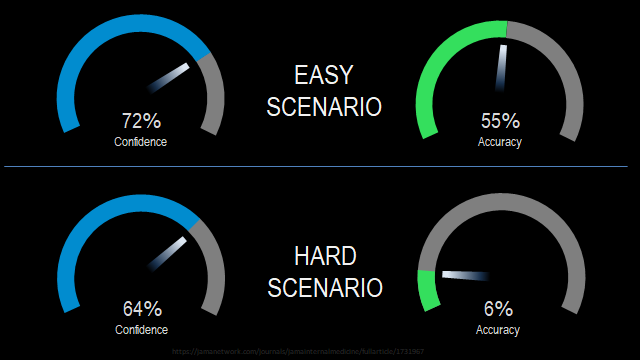
How do you know what you know?
In 1847 a Hungarian doctor, Ignaz Semmelwies, proposed a controversial idea – that physicians should wash their hands between messing around in cadavers and then touching a patient’s vagina. Semmelweis was deeply bothered by the 18.4% maternal death in the local clinic and thought that disinfecting physician’s hands could reduce this rate so he designed an experiment around it. This was before the germ theory of disease was accepted and physicians believed that disease was caused by bad airs known as miasma or because of dyscrasia, a derangement of one of the four humors.
Semmelwies, being a man of science, looked at all the variables between this hospital with the 18.4% maternal death rate and other hospitals with much lower maternal death rates. He quickly realized that some hospitals did not employ physicians but used midwives instead and he wondered if this could be the difference as physicians of that time frequently used cadavers for training but midwives were not afforded the luxury of training on cadavers. Semmelwies was convinced the physicians were somehow transferring “cadaveric particles” to the patients and that was causing the high maternal death rates and he designed an experiment to test this hypothesis.
He had physicians disinfect their hands with a solution of lye between patients and when going from between the cadaver lab and a patients. In the thirty days in which the physicians disinfected their hands the maternal death rate dropped from 18% to just 2%.
You would think his colleagues would have heralded him a hero, crediting Semmelwies with a discovery that could save hundreds of thousands, if not millions of lives, at virtually no cost. That did not happen, in fact, tragically, just the opposite did. His idea, which seems like a rather reasonable one, was not received well by his colleagues at the time. The medical establishment was highly offended by the idea that they could be a vector for disease and they refused to disinfect their hands. Outraged, his colleagues took it upon themselves to blacklist Semmelwies and they ruined his career.
Semmelwies died tragically at the age of just 47, bankrupt and insane, he was committed to an asylum where he died from wounds on his hands that became infected after a particularly vicious beating from the guards. It would be another twenty years until the germ theory of disease was accepted and his asshole colleagues would have to wash their hands and admit he was right.
In many ways the medical field has not really changed since 1847. It might simply be human nature to revolt against facts that challenge our beliefs and view of how the world works. Sometimes, when the evidence is overwhelming and the rational thing to do would be to change admit we were wrong and update an incorrect belief a sort of doubling-down on the wrong belief occurs, known as thebackfire effect. Examples of this effect can be found in anti-vaccine forums and flat-earth YouTube videos and maybe in the comment sections of some EMS social media sites.
“the new scientific truth does not triumph by convincing its opponents and making them see the light, but rather because its opponents eventually die, and a new generation grows up that is familiar with it” – Max Planck
There are some really smart EMTs and paramedics out there. Unfortunately, most of these people who are intellectually gifted have probably already left the EMS field and gone to nursing school or PA school or medical school, or have gotten out of EMS entirely. Somedays I can’t say that I blame them.
Some EMS providers are a strange mix of being woefully undereducated and yet somehow strangely overconfident at the same time. They are certain that whatever knowledge they know is an incontrovertible truth. This would be an easy segue into the Dunning-Kruger effect, but that horse has beaten to beyond death by now so we’ll skip it.

Asking the question “how do you know, what you know, is correct” often just elicits blank stares from people. Much of this information that resides in the brains of EMS providers is believed to be a cold hard fact because it probably came from someone viewed as authority or expert at one time. Further complicating the fact is that if the idea has been turned into action – like the hundreds of people I placed on backboards to prevent their imminent paralysis- that changing our minds requires us to say we were wrong. While this should not be a big deal, and it is something we expect from others, it can be hard to say. The good news is it gets easier to say I was wrong the more you do it.
It is the rare EMS provider that engages in thinking about their own thinking; actually it is probably just a rarity in all of humanity. Many providers go to a paramedic program that may be little more than two semesters of NREMT jazz-hands high school play rehearsal, antiquated and incorrect dogma, and some anecdotal war stories. They graduate with a head full of half-truths, a bit of bullshit and an incomplete understanding about many things that are not as simple as we were led to believe they are.
Poor initial education is not the students fault as they could not have known any better at the time. But what is alarming is the lack of self-reflection, the lack of humility and the lack of doubt these paramedics and EMTs possess, and that goes for nurses, mid-levels and doctors as well. Go on any forum and post a controversial idea and for every one person that engages in exploring the idea – asking about data and evidence and science- there will be ten morons who will turn it into an ad hominem attack and call you a paragod or tell you that you are going to kill people. Asking them how they know what they know doesn’t usually bring the conversation back to a productive place; it usually causes them to leave it. These days I am less inclined to get into many debates about EMS things on social media.
Not to pick on doctors here but this is probably the best data on this as there is little data on paramedic or EMT decision making, but I think this data would be the same no matter the level of provider. If I an being honest here, I suspect it might even be a bit worse in EMS. In thisstudy researchers gave doctors two scenarios, an easy scenario and a much harder scenario. The researchers asked the doctor to provide two things, a diagnosis and a probability of how certain they were in their diagnosis based on the two cases. For the easy scenario the doctors got the correct diagnosis 55% of the time and they felt confident in their diagnosis 72% of the time. For the harder scenario the doctors felt confident they had the right diagnosis 64% of the time…unfortunately they only got the diagnosis correct 6% of the time. While the doctors had drastically different results in diagnostic accuracy between the hard and easy scenario their confidence in the diagnosis barely changed at all. This is known as overconfidence and it is another one of the hard wired flaws of the human mind.

Referencing Daniel Kahneman’s Thinking Fast and Slow and the notion of system 1 (fast) and system 2 (slow) thinking, it takes work and energy to engage the critical thinking and self-reflection of system 2 thinking and to really check if what we believe to be true is actually true; it burns both glucose and will-power to honestly evaluate our beliefs and ideas. The human brain is lazy (or efficient in conserving energy) and it does not like to readily do this sort of work. Throw in an ego that hates to be wrong and this type of self-reflection is something that probably happens rarely, if at all, in most people. Of course, this is all dependent on the whole schematic presented by psychology and specifically Kanehman and Tvorsky being an accurate representation of reality and not some gobbledygook that we simply accept without verifying it to be true, which I might have done here.
Doing the work required to have an opinion. Many EMS providers have all sorts of strong opinions about things that they don’t really know about. This is not just an EMS phenomenon of course and not just a medical provider phenomenon either, it is just how humans are, but this is a blog about medical stuff so we will talk about that.
Charlie Munger, a person who I find myself talking about more and more as I age, talks about doing the work required to have an opinion. What is the work required to have an opinion? It is being able to argue both sides of the issue. Click Here Evaluating beliefs and ideas is not a concept that is taught in any EMS education that I have ever encountered. What usually happens in EMS is an EMT or paramedic hears a fact like, “albuterol given to a CHF patient will turn them into a veritable geyser that will erupt from the depths of their lungs, kind of like that flood scene in that Noah movie with Russell Crowe from a few years ago, and the patient will drown right in front of you. You’ll be lucky if you stay dry when this happens if you’re in the ambulance with them,” and this is cemented as fact in the brains of impressionable EMT and paramedic students without any further reflection. This has happened many times before in EMS – remember when we were certain that a backboard was the only thing that would prevent paralysis or that patients needed to get 3:1 IV fluids for blood loss, etc. I know I have been guilty of many of these things in the past.
It is tempting to think that the longer you do this, the more certain things become, but that is not the truth, not all, although I wish it was. Living with certainty is easy, living with uncertainty is much harder; it is often uncomfortable and it often means saying things like “maybe” and “I don’t know.”
Being wrong is okay, it is the backbone of science to be wrong and when new information comes to light to reevaluate your views on a subject. Sometimes science straight up sucks because you have to admit that you are wrong.
Be ready to walk away from every belief you hold, realize every truth you know to be certain is a lie and to murder your entire herd of sacred cows if need be. There is no room for egos, self-delusion or bullshit at the top.
“We all are learning, modifying, or destroying ideas all the time. Rapid destruction of your ideas when the time is right is one of the most valuable qualities you can acquire.”
When I first started writing on blogs and EMS social media I wanted a platform to show others just how much I knew and just how smart I was. I was wrong. I don’t want to lie to you, investigating how you know what you know sucks. It isn’t fun or glamorous; it won’t build up your ego or self-esteem. There are no trophies given out for stripping away self-delusion. Finding out your head is packed full of bullshit is not a pleasant experience but it will change your life for the better, if you let it.
__________________________________________________________ Brian Behn is a paramedic in the mountains of Colorado. He writes about EMS with an emphasis on human factors in EMS.
Source
https://www.foamfrat.com/single-post/2019/01/03/Seldom-Wrong-But-Never-In-Doubt